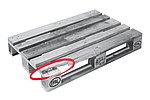EPAL 7 half pallet
The new EPAL 7 half pallets are particularly popular in the food and drink industry, as well as with discount stores and the retail trade. They are perfectly suited to placing in the POS area.
- EPAL half pallets are safe worldwide and across borders.
- EPAL half pallets guarantee smooth transport of your goods.
- EPAL half pallets ensure stable storage of your goods.
- EPAL half pallets ensure maximum occupational safety thanks to their high quality.
- Product Sheet
SPECIFICATIONS
Boards: 13
Nails: 42
Blocks: 3
Steel angle brackets: 6 sturdy 3 mm steel angle brackets
Tubular rivets: 21
Length: 800 mm
Width: 600 mm
Height: 163 mm
Weight: approx. 9.5 kg
Safe working load: 500 kg in shelving racks or transport with a forklift truck
When stacking laden pallets on a solid, even surface, the bottommost pallet must not exceed a load of max. 1,500 kg.

MARKINGS
1/2 Steel spacers bearing the embossed markings of the European Pallet Association e.V.
3 IPPC branded marking in accordance with the national plant protection rules (mandatory since 01/01/2010 for EPAL pallets)
4 Country code
5 Registration number of the responsible Plant Protection Authority
6 Method of treatment (heat treatment)
7 EPAL control staple (mandatory)
8 Repair marking nail (only present if the pallet is a repaired EPAL pallet)
9 Licence number – Year – Month
10 Plastic block
Non-exchangeable EPAL half pallets:





- The safe working load is no longer guaranteed (rotten and decayed, heavy splintering, damaged stringers).
- The pallet is contaminated in such a way that this may lead to the contamination of the payload.
- Heavy splintering is visible on several blocks.
- Unacceptable components have clearly been used (e.g. boards that are too thin, blocks that are too small).
EPAL half pallets that are not fit for use in accordance with the quality classification should be repaired in accordance with the EPAL Technical Regulations.
- EPAL half pallets may only be repaired by licensed repair operations.
- The repairing of EPAL half pallets without an EPAL licence shall be legally prosecuted.
- Only dimensionally accurate components may be used in accordance with the EPAL Technical Regulations.
- Following repair, EPAL half pallets should meet the quality classification for fit for use.

- Since 01/01/2010, all newly produced EPAL half pallets are heat treated in accordance with ISPM 15.
- EPAL half pallets treated according to ISPM 15 can be recognised by the branded markings on both central blocks on the long sides.
- It is prohibited to treat EPAL half pallets with methyl bromide (MB).
- EPAL 7 half pallet boards must have a thickness of between 22 and 24 mm (stringers up to 25 mm).
- There may not be any wanes on them.
- Poplar wood is not permitted for use.
- The bottom boards must be chamfered on the upper edge of both 600-mm sides.
- The position of the 42 nails used is stipulated in order to guarantee the diagonal rigidity of the pallet.
- The nail pattern must be even and repetitive.
- In accordance with the construction standard, the nails must be positioned with the greatest possible distance between them and at least 20 mm from the edges of the components.
- All nails used to construct EPAL half pallets bear a head marking comprising two letters.
- Only those nails that have been approved by EPAL, and which have additionally been verified by a neutral testing institute, may be used to assemble EPAL half pallets.
- Only tubular rivets that have been approved by EPAL, and which have additionally been verified by a neutral testing institute, may be used to assemble EPAL half pallets.
